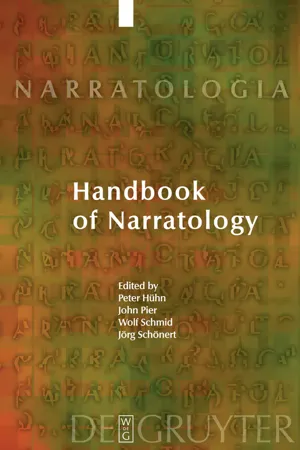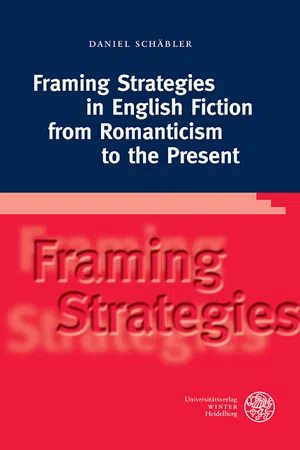Literature
Framed Narrative
A framed narrative is a storytelling technique where one narrative serves as the framework for another. It typically involves a story within a story, with the outer narrative providing a context or setting for the inner narrative. This technique allows for complex storytelling and can provide different perspectives on the events and characters within the narrative.
Written by Perlego with AI-assistance
Related key terms
1 of 5
3 Key excerpts on "Framed Narrative"
- eBook - PDF
- Peter Hühn, John Pier, Wolf Schmid, Jörg Schönert, Peter Hühn, John Pier, Wolf Schmid, Jörg Schönert(Authors)
- 2009(Publication Date)
- De Gruyter(Publisher)
When examined from the perspec-tive of narrative levels, frame tales must be qualified as a particular type of intradiegetic narrative with regard to the narrative in which they 304 Narrative Levels are contained (cf. Ryan’s type 4a border crossing) and are thus, how-ever brief they might be, subject to the criteria of narrativity in their own right (cf. Wolf 2006: 181). In addition to change of voice and level and to the potential for multiple levels of embedding, narratives that employ the framing technique—and this accessorily to the prin-ciple of narrative embedding properly speaking—can incorporate a single second-level narrative ( Heart of Darkness ) or multiple second-level narratives (the Arabian Nights ) as well as, within a given second-level narrative, additional embedded narratives (as in “The Three Ladies of Baghdad”). A fourth feature of frame stories is their compo-sitional distribution: a framing can be complete (appearing at the be-ginning and end of the embedded story), incomplete (introductory only or terminal only, possibly producing metaleptic effects), or interpolated (appearing intermittently) (adapted from Wolf 2006: 185–88). Overall, the frame tale, together with its second-level narrative, re-lies heavily on compositional means. Most notably, it offers the possi-bility of linking together an otherwise disparate group of stories and of establishing thematic relations among them, and it thus contributes to textual → coherence. Semiotically, this corresponds to the syntactic di-mension of semiosis. Another feature of the frame tale, particularly in its written form, is that it replicates the communicative situation of oral storytelling, indicating a time and place of the narrative act and the audience and buttressing the “narratorial illusionism” of the framed tale (Kanzog [1966] 1977: 322; Nünning 2004: 17; Williams 1998; 110, 113; Wolf 2006: 188–89). - No longer available |Learn more
- Daniel Schäbler(Author)
- 2014(Publication Date)
- Universitätsverlag Winter(Publisher)
(1992, 13) Readers are thus by no means the passive “victims” of the text’s framing strategies, but, based on their individual knowledge and education, consciously or subconsciously shape their own interpretation of the textual data according to their own disposition and needs. Texts are thus a stage for “a struggle to possess the meanings of what is told” ( ibid ., 14). 1.3 Placing the Story: Framing-Strategies in Narrative Texts Focusing now in more detail on narrative framings in literary texts: How are these to be defined and what are their functions? After all, they often aim at self-effacement while subtly influencing the reception of the text: Narrative frames take a paradoxical status: they are relatively commonplace and conspicuous features in narrative, while at the same time they are occulted or valuable precisely insofar as they disappear. […] frames are constituted as invisible or disposable, as peripheral and only significant as a segue to the narrative proper. […] Frames presuppose their own forgetting. (Williams 1998, 99) Framings are at best often regarded as “subservient” (Wolf 2006b, 181) to the main text, thereby relegated to an aesthetic device that serves to facilitate the reader’s transition into the main text. At worst, they are disregarded all together because “the intuitive or natural assumption is to see plot as the content of narrative” (Williams 1998, 4). But what functions can intratextual extradiegetic framings fulfil? To give a working definition, they can be described as a “relatively complete depiction of a discrete Introduction 20 narrative scene, placing the narrative in time and circumstance separate from the time and/or circumstance of the embedded narrative”. This “scene” can be augmented by a concrete “narrative circle”, a “narrative cause”, and “narrative adverts, explicit depictions of the narrative-to-be-told and of the narrative desire of the narrative circle” (Williams 1998, 108). - eBook - PDF
- John Pier, José Angel Garcia Landa, John Pier, José Angel Garcia Landa(Authors)
- 2011(Publication Date)
- De Gruyter(Publisher)
But many literary narratives (the case seems to be rarer in film) pro-vide interferences of the framing within the framed story—reminders that there is a frame—and some (not many) may choose to emphasize the telling for its own sake as an event, not just as a convention to frame a metadiegetic story. In narrated narrating, the intradiegetic narrator's nar-rative activity is visible and foregrounded so that the story told may be frequently interrupted and so that narratees may be prominent and articu-late. John Barth proposes a further degree of complication that may be achieved by some frame narratives: Imposed upon the genre of frametales, an order of climax suggests the possibility of a dramaturgical relationship among the several degrees of narrative involvement: a nar-rative strategy in which the inner tales bear operatively upon the plots or plots of the outer ones, perhaps even precipitating their several complications, climaxes, denoue-ments. 72 71 Benjamin (1969 [1936]: 87). 7 2 Barth (1981: 56). 444 Jose Angel Garcia Landa Barth's own tale Menelaiad (in Lost in the Funhouse [1968]) is a spectacularly complex game and experiment with such possibilities. 7. Configuration and Retelling Following Barbara Herrnstein Smith's critique of structuralist narratology, many recent theories of narrative have emphasized the interactional, communicative and situational origin of narrative concepts, favoring the study of narrative structure as a negotiation between different narratives, rather than as an operation confronting abstractive plot or story levels and a surface text. For McQuillan, for example, all verbal and linguistic acts become narratives as articulations of the inter-subjective. 73 Sarbin, too, has emphasized the communicative and social-experiential basis of narra-tive. 74 And then there is Morris Zapp's Peircean dictum: every decoding is another encoding.
Index pages curate the most relevant extracts from our library of academic textbooks. They’ve been created using an in-house natural language model (NLM), each adding context and meaning to key research topics.


